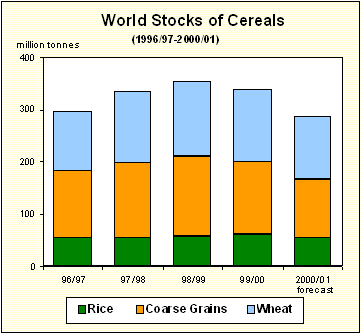


World cereal stocks by the close of the seasons ending in 2001 are now forecast at 288 million tonnes, down 52 million tonnes, or 15 percent from their opening level. This significant reduction comes mostly as a result of lower world cereal production. As a result, the ratio of world stocks to the expected utilization in 2000/01 could fall to around 15 percent.
The biggest declines in cereal stocks are expected in countries where production is forecast to fall most, namely China and the United States. Total ending cereal stocks in major exporting countries are now put at 130 million tonnes, which is 16 million tonnes below their opening levels. Although total cereal inventories in major exporting countries are forecast to decline, because of even larger drawdowns in other countries, the share of global stocks held by major exporters is forecast to rise slightly from the previous year to around 45 percent. However, the ratio of the volume of cereal stocks held by the major exporters to the total disappearance (their domestic cereal consumption plus exports) in 2000/01 is likely to decline fom the previous year. For coarse grains, despite the expected increase in production in the major exporting countries, high world import demand and domestic use could result in a decline in the stocks-to-use ratio from 18 percent in 1999/2000 to 16 percent in 2000/01. The ratio for wheat is also likely to decline, from around 22 percent to 18 percent due to strong international demand. For rice, a sharp fall is expected, from 11 percent in 1999/2000 to 8 percent in 2000/01, largely because of a likely decline in rice production in China.

In some countries, recent policy changes have brought about reductions in domestic grain inventories, largely driven by changing global trading environment and the need to reduce the ever-growing financial burden associated with managing such large stocks. This calls for a closer look at a change in the level of stocks held particularly by the major producing countries. FAO will review the stock levels for such countries and refine its estimates, as necessary, in the future reports.
World stocks of wheat for crop years ending in 2001 now put at 121 million tonnes, some 18 million tonnes, or 13 percent, below the previous year's level. Among the world's five major wheat exporters, the overall declines in the United States and Canada are expected to more than offset the anticipated rise in stocks held in the EC. However, the largest decline is in China, where wheat stocks are forecast to fall by at least 10 million tonnes, mostly because of smaller domestic production. Sharp drops in stock levels are also anticipated in a number of other drought-stricken countries, including Afghanistan, the Islamic Republic of Iran, Iraq, Jordan and Morocco. By contrast, wheat inventories are likely to expand in Pakistan and India because of bumper crops, and also in the Russian Federation because of improved harvests this year.
| Crop year ending in: | |||
| 1999 | 2000 estimate | 2001 forecast | |
| (. . . . million tonnes . . . .) | |||
| Wheat | 143.0 | 139.1 | 120.7 |
| Coarse grains | 153.9 | 138.8 | 112.2 |
| Rice (milled) | 56.8 | 61.8 | 55.1 |
| TOTAL | 353.6 | 339.7 | 287.9 |
| of which: | |||
| Main exporters | 154.4 | 146.6 | 130.4 |
| Others | 199.2 | 193.1 | 157.5 |
Global coarse grain inventories for crop years ending in 2001 are now put at 112 million tonnes, down 27 million tonnes, or 19 percent, from the previous year. As for wheat, the bulk of the decline is accounted for by China, where stocks are now forecast to fall by about 17 million tonnes, following a sharp drop in production. In the United States, the ending stocks are forecast at around 50 million tonnes, up slightly from last year but significantly (around 17 million tonnes) below the previous forecast in September as the estimate for this year's coarse grain production has been reduced further and the forecast for exports has been raised. Smaller stocks are also anticipated in several eastern and central European countries due to drought-reduced production.
World rice inventories at the end of the 2000/01 marketing season are now forecast at 55.1 million tonnes, about 7 million tonnes less than their opening level. As for the other cereals, China (mainland) is expected to account for most of the stock drawdown, as the Government is striving to lessen the financial burden associated with holding stocks ahead of the country's accession to WTO. Carry-over stocks are also expected to fall in India where free or low-priced domestic distribution of rice has been promoted to release storage space following bumper wheat harvests. The stock drawdown might also reflect rising concern over the potential implications that the forthcoming tariffication might have on the country's cereal balances. Japan is also expected to cut holdings by promoting rice utilization in feeds and food aid transactions. Among the others exporters, stocks are anticipated to fall somewhat in Pakistan, Thailand, the United States and Argentina. By contrast, they might remain unchanged in Viet Nam or even increase in Myanmar. In general, the tendency to reduce inventories is expected to prevail in all regions, since utilization is anticipated to outpace production.